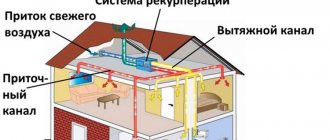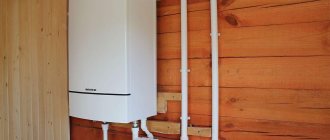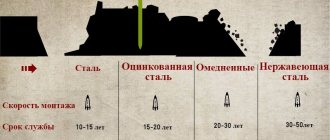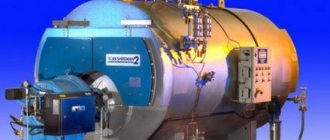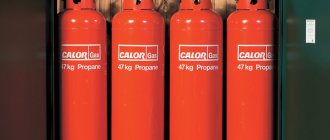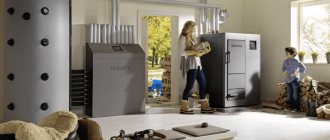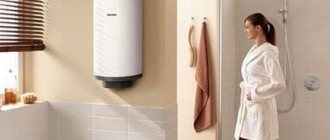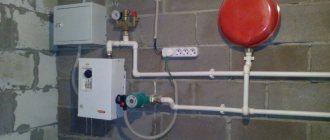Electric heating – heating a house, apartment, industrial premises using electrical heating appliances. Characterized by a wide variety of equipment used, this inexpensive type of heating has recently gained great popularity among owners of private houses and apartments.
Electric heating appliances for the home - convenience, safety, ease of operation
Pros and cons of heating your home with electricity
The main advantages of using electric heating devices are:
- Simplicity and ease of installation - installation of electric heating equipment can be carried out by persons who do not have special permission. The installation process itself requires minimal skills and knowledge in the field of heating systems;
- Safety – electric heating devices have reliable and simple protection against short circuits, overheating, and exceeding the parameters of the established settings;
- Low initial costs - thanks to self-installation and the relatively low price of the equipment;
- Reliability and noiselessness - heating equipment of this type has a long service life and high quality manufacturing;
- Ease of operation - adjustment and control of heating devices has a simple and intuitive interface;
- High level of efficiency - the efficiency of modern electrical heating appliances ranges from 80 to 98-99%.
The disadvantages of using electrical heating appliances are the following:
- High cost of paying for electricity - since heating equipment consumes from 0.4-0.5 to 10 or more kW of electricity per hour, this leads to significant electricity bills;
- Energy dependence - when the electricity is turned off, the heating device, therefore, the entire heating system stops functioning.
Important! Heating a house with electricity will be cheap for people who have socially reduced tariffs for electricity (these are WWII veterans, large families, Heroes of Russia and the USSR, orphans). It is also profitable to heat a small country house using electrical appliances - not all country houses have gas supply.
Heat pumps
The main purpose of a heat pump is to pump thermal energy. The most famous type of it is the ordinary refrigerator. Inside it, thermal energy is taken from the refrigeration chamber, with its subsequent release into the surrounding space.
The complete operating cycle of a heat pump includes the following stages:
- Compression of freon gas by a compressor. Due to the increase in pressure, it turns into a liquid aggregate state. This is accompanied by an increase in temperature by several tens of degrees.
- Passing hot refrigerant through the pump's internal heat exchanger. In this case, excess heat is transferred to the coolant or air in the room.
- The return of cooled freon to a gaseous state after it passes through the expansion valve. We are talking about a section of the contour with a sharply increasing diameter. After turning into gas, a sharp decrease in the temperature of freon is observed.
- Circulation of refrigerant through an external heat exchanger with its subsequent heating. This is achieved by taking heat from the external environment: its temperature is an order of magnitude lower than the air in the heated room, but higher than that of the refrigerant.
- Compression inside the compressor and exit to the next cycle.
This achieves the following advantages:
- The temperature outside, which acts as a heat donor, is often an order of magnitude lower than the air temperature in the home.
- In this scheme, only the compressor consumes electricity. At the same time, the level of its electrical power is often an order of magnitude lower than the thermal power of the pump. This refers to the volume of thermal energy that is pumped by the pump into the home per unit of time.
With the help of the most efficient heat pumps, it is possible to obtain up to 7 kW/hour of heat energy for every kilowatt/hour of electricity consumed. To install such pumping equipment, it is recommended to invite a dealer representative: this will allow you to get a good warranty on the equipment. Water heating operating in combination with such a device must be low-temperature (operating temperature - no more than + 55 degrees).
This will make it possible to achieve the highest possible efficiency of the heat pump. In this case, the temperature difference between its heat exchangers will be the smallest. Heat pumps with an internal water circuit are usually combined with water heated floors or conventional batteries with an increased number of sections.
Types of electric heating
What should street lighting devices be like?
Depending on the coolant used, the following types of electric heating systems are distinguished:
- Water heating with an electric boiler - the coolant (water, antifreeze) is heated in electric boilers, after which, using a circulation pump, it enters the supply line and is distributed to the radiators heating the rooms. After the radiators, the cooled coolant returns through the return line back to the boiler.
Water electric heating
- Air heating with electric heaters - in such systems, the role of the coolant is played by air heated to a certain temperature by heating elements or metal surfaces of electrical heating appliances.
Air electric heating
- Warm floors using electric elements - a tube with liquid and a heating cable placed under the subfloor. Heating of premises with such a system occurs due to the natural movement of heated air from the floor.
Warm floor
Conclusion
Despite all the advantages of an electric boiler, we see that the cost of heating with a classic type electric boiler (TEN) is high. Gas heating will be cheaper, although the profitability of gas heating will appear in the third or fourth year after investing in gasification of the house.
In addition, power outages are possible. This is why professionals advise using an electric boiler in tandem with an additional heating boiler, for example, using solid fuel.
©Obotoplenii.ru
Other articles in the section: Heating boilers
- Combustion chambers of a gas boiler
- How to flush the heat exchanger of a gas boiler
- Installation of a gas boiler: preparatory work for installing a gas heating boiler on the wall
- Automation of heating boilers
- How to connect a heating element to a 380 Volt and 220 Volt boiler
- Stages of installation of a long-burning solid fuel boiler
- Electric heating boiler (electric boiler): device, connection to power supply
What type of electric heating is the best?
Dust and waterproof lighting fixtures for any need
The choice of the most economical electric heating depends on the purpose and area of the heated room:
- A water electric heating system is used as electric heating for a house or cottage with an area of 100 square meters;
- To heat apartments in high-rise buildings, more convenient and economical air heating devices are used;
- To heat small living spaces with an area of up to 10-15 square meters, a heated floor system is used.
The specific feasibility of using a particular heating equipment is calculated for each particular case separately.
Warm floor
Underfloor heating refers to a heating system where, instead of standard radiators, heat is radiated from the floor surface.
For this purpose, the following design solutions can be used:
- A system of thin pipes with coolant. Placed under a screed or on a special heat distribution platform under the finishing coating.
- Heating cable. It can be mounted both in the screed layer and in the thickness of the tile adhesive under the tiles.
- Film heater. A dense dielectric sheet of polymer is used as a heating element. It has two copper current-carrying wires connected to each other by current-carrying elements with high electrical resistance. The place where film heated floors are laid is usually the last layer under the finishing floor covering with high thermal conductivity. Usually this is linoleum, laminate or parquet board.
The inertia of a film laid under a final coating is an order of magnitude less than that of a cable under a tile or screed. The time required for the film heater to bring the floor covering to a comfortable +25 degrees is no more than 5-10 minutes. At the same time, a cable under a tile does this in 30 minutes, and a cable in a screed does it in 3-5 hours.
Installation of the heating film is so simple that the procedure for installing this electric heating with your own hands usually does not cause difficulties:
- Laying the substrate. For these purposes, a special material is used - penofol (foamed foil insulation). It needs to be laid out on a rough base with the foil facing up.
- Connection with thermostat and network. It is necessary to crimp the terminals on the current-carrying conductors and on the wire. Bitumen overlays are used as insulation. A thermal sensor is installed under the surface of the film.
- Finishing. Suitable options for finishing material on top of the film heater are laminate, linoleum or parquet.
It is recommended to consider the following tips on how to make electric heating with your own hands:
- One thermostat can withstand a load of no more than 3.6 kW. It is advisable to equip large premises with several separate power circuits with autonomous thermostats.
- It is prohibited to apply heating film to areas of the floor under furniture and other objects adjacent to the floor. Like other electrical appliances, the film does not tolerate overheating.
Electric boilers for water heating
Thermostats with temperature sensor
Electric boilers according to their operating principle are divided into heating elements, electrode and induction.
Electric boilers heating elements
New heating element
Boilers of this type consist of the following parts:
- Frame;
- Heat exchanger tank with 1-3 heating elements inside and external thermal insulation;
- Control block;
- Coolant pressure and temperature sensors;
- Supply pipe with safety group;
- Return with circulation pump.
The operating principle of such a boiler is to heat the coolant when it comes into contact with the surface of the heating elements.
Electrode heating boilers
Electrode boiler
Such boilers consist of:
- Cylindrical body;
- 1-3 electrodes connected to the electrical network phase;
- Supply and return pipelines;
- Circulation pump;
- Connectors for connecting the neutral wire and ground loop, located on the outer surface of the housing.
The coolant in such a device is heated by passing an alternating electric current through its thickness.
Induction electric boilers
Induction electric boiler
This type of boiler, compared to previous ones, has the highest efficiency, safety and reliability.
Such electric heaters for the home consist of a heat exchanger tank, inside of which there is a core with an induction coil (inductor). When electric current passes through the coil, the resulting eddy currents heat the walls of the tank, the core and the coolant itself. To circulate the coolant, the tank has supply and return pipes and a circulation pump. Control and configuration are carried out using an electronic unit.
Cost of different types of electric boilers
The cost of modern electric boilers is:
- Heating elements - from 1,800 to 18,000-20,000 rubles;
- Electrode - from 4,000-7,000 to 30,000 rubles;
- Induction – 28,000-40,000 rub.
More expensive models of heating units are suitable for heating large cottages and industrial premises, while budget ones are suitable for small private and country houses.
Electric boiler with automation
Most often, electric boilers have an automatic control system. This fact is a great advantage for the user. After all, he will need to initially set the required temperature regime, after which the unit will work on its own.
More expensive products have a control unit with a microprocessor that allows you to set a home heating program. Here you can also set the temperature, operating time and everything. This function is quite convenient, because if there are no people in the house, then why heat it up at full power when you can save a little.
Before you start purchasing an electric boiler, you need to thoroughly study the range of products on offer, then calculate the required boiler power, check for heat losses in the room, and minimize them if possible. It is also worth considering what type of electric boiler is suitable and then buy the electric boiler that it needs for your home.
Heating a home using electric heaters
The following electrical appliances are used for air heating:
- Air convectors are devices consisting of a housing with a heating element inside. During operation, cold air enters the convector, is heated by a heating element and naturally exits through the grille located in the upper part. Depending on the location, convectors can be floor-mounted or wall-mounted.
Electric convector
- Oil heaters - heating of a room with such electrical appliances occurs by heating a sealed housing (radiator) filled with oil, located inside heating elements.
Oil electric heater
- Ceramic heating panels are devices that heat rooms due to the convection of warm air by a ceramic surface heated by tubular or flat electric heat-generating elements (heating elements, heating cable) located underneath it.
Ceramic heating panel
- Infrared emitters are heaters that heat a room by heating objects within the device’s coverage area with infrared rays and then releasing some of the heat to the air around them. A classic device of this type is a housing with a quartz transparent tube, inside of which there is a spiral made of nichrome or tungsten wire that heats up and emits infrared rays.
Infrared emitter
Features of use
When using convection heating (conventional wall-mounted radiators), a heating effect is observed, first of all, in the space under the ceiling. In this case, less dense heated air flows move upward. It turns out that the air temperature of +20 degrees at floor level can be achieved in cases where the area above the head is heated to +26-30 degrees. Warm floors work differently: in this case, the area above the floor heats up the most. As warm air rises, its temperature decreases.
Advantages of electric heating in a private house using heated floors:
- Indoor comfort. Having warmth at foot level is always much more pleasant.
- There are no drafts above the floor. This allows you not to worry about the health of small children who like to play on the floor in the room.
- The average temperature level in the home decreases. Thanks to this, a noticeable economic effect is achieved, because heat losses in a heated room are directly related to the temperature difference outside.
The disadvantages of film floors usually include their high cost. Even if you carry out the installation yourself, choosing the most inexpensive option for a system with a mechanical thermostat, the financial costs will still be significant. In cases where installation work is carried out by hired workers, costs will increase by approximately 1.5-2 times.
How to make electric water heating economical
In order to make electric heating economical, experts advise:
- Install boilers with a design power that compensates for heat loss from all parts of the structure;
- If there is no circulation pump in the boiler, it is mandatory to install it in front of the heating unit in the return line;
- Use pipes with an internal diameter of no more than 32 mm for intra-house heating distribution;
- Use cast iron radiator models;
- Insulate external walls.
Device
The donor environment of the system is usually:
- The soil is below the freezing level. Away from the upper layers, the temperature of the earth is mostly stable (within +10-14 degrees).
- Non-freezing reservoir or groundwater. They are pumped out from the well with a good supply. After heat transfer, the water is directed to the drainage.
- Air outside. The minimum air temperature is limited by the characteristics of the refrigerants used. The optimal temperature level for the operation of air heat pumps is no less than -25 degrees. As this value decreases, the efficiency of the pump will also decrease.
As a result, to obtain 1 kilowatt of heat, 2.5-7 less energy is required than to obtain a kilowatt of electricity. To some extent, this is influenced by the characteristics of the device and the temperature of the heated home. The disadvantages of this heating method include the high cost of equipment.
Do-it-yourself electric heating circuit for a private house
Electric heating of a private house - boiler piping diagram
The main components of a classic do-it-yourself electric heating circuit for a private house are the following:
- Boiler;
- Safety group (pressure gauge, air vent, pressure relief valve) on the supply;
- Dirt filter and circulation pump on the return line;
- Expansion tank on the return line.
When installing electric heating with your own hands using expensive boilers, the unit is connected to the piping (heating circuit) without installing an external pump, safety valves, expansion tank, dirt filter - these elements are already installed inside the boiler.
Thus, electric heating of a house, with the right approach to the selection and installation of equipment and the system itself, is a good alternative to gas and solid fuel boilers.
How to organize a connection to an open-type gravity heating network
An electric boiler works best with coolant circulation. But installing a pump is not considered mandatory; the equipment can work properly with a gravity heating system.
Owners of private houses often deliberately choose a double scheme - with a pump and gravity. The reason is quite simple - the built-in pump hums a lot, so when resting at night, the heating is switched to gravity.
The system is based on a bypass assembly with a valve and an electric pump. The boiler can operate due to the presence of waste slopes. Without them and without installing an open-type expansion tank at a height of at least 250 cm above the level of the lowest return point, water movement would be impossible.
Air conditioners
An air conditioner is often perceived as a device for cooling air. It is important to understand that any such device is a type of heat pump operating on an air-to-air cycle. If you start it for heating, it demonstrates no less efficiency than similar direct heating equipment. The ratio of thermal power to consumed energy for modern inverter air conditioners is in the range of 3.6 - 5.
Heating functions can be effectively performed at a lower operating temperature of -25 degrees. In regions located in central Russia, air conditioners often serve as an auxiliary heat source, regardless of the time of year. Installation of equipment can be carried out either independently or by numerous companies. The most convenient in this regard are considered to be window models, the installation location of which is often an open sash.
Installation site requirements
When carrying out installation work, it is necessary to follow the rules that will make it easier to service the equipment in the future.
Heating elements units must be hung at a height of 1.5 m from the floor for the convenience of regular technical inspection of the device. Induction and ion instruments can be placed at low heights, but only require vertical installation.
For operation, single- or three-phase voltage is supplied.
When mounting it on the wall, you need to make sure of its quality - it must withstand the weight of the device and the devices connected to it. When laying pipelines, it is not allowed to secure heating pipes near the water supply, but if this option is not possible, then use a protective box or sleeve.
When installing an electric boiler, the distance from the ceiling to the unit must be at least 70 cm, and on the sides - 50 cm from the walls of the room.
The place where equipment is hung must be protected from moisture. Free space is needed nearby, since the power supply circuit requires the installation of automatic circuit breakers and RCDs on each phase.


